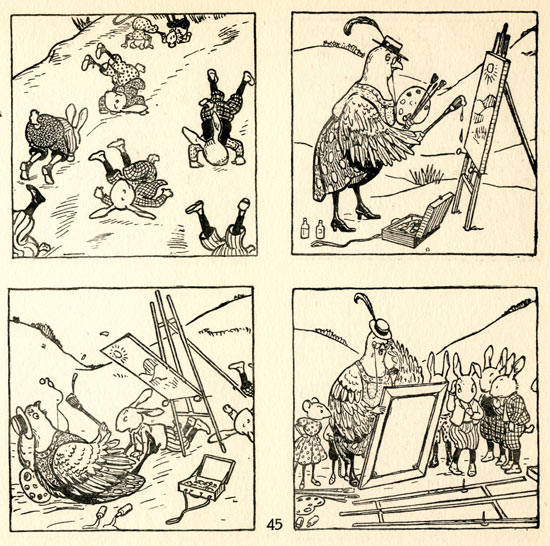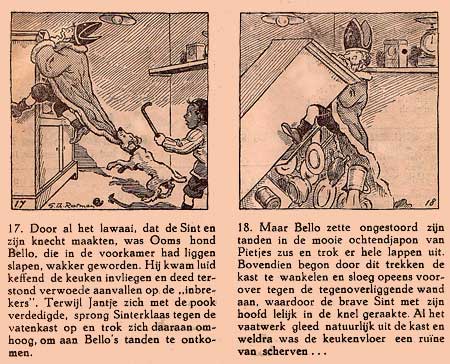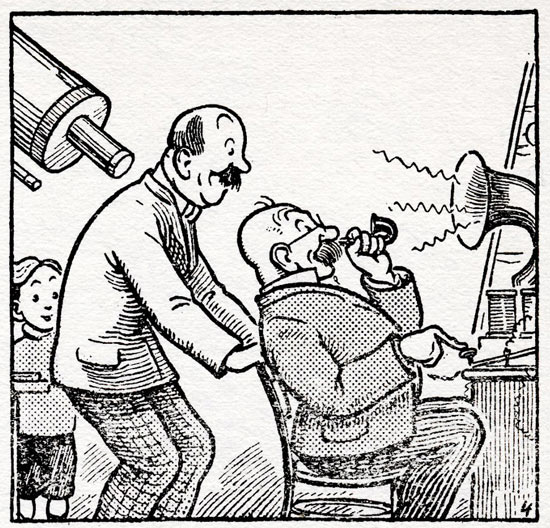'Snuffelgraag en Knagelijntje'.
Gerrit Rotman is one of the Netherlands' major comic pioneers, besknown for his newspaper comic 'Mijnheer Pimpelmans'. Born in 1893 as Gerrit Theodoor Rotman in Groningen, he studied at the Art Academies of Rotterdam and The Hague, but lack of funds forced him to go into teaching. After serving in the First World War, he became a head teacher at the age of 25. In 1921, he decided to fully devote himself to drawing, following the advice of cartoonist Johan Braakensiek.
'Pietje Pluis en Jantje Joppe'.
Rotman's first comic (then called a "picture-story") was 'Snuffelgraag en Knagelijntje', about the adventures of a brother and sister mouse, written by Arie Pleysier. It appeared in 1924 in the socialist periodical Voorwaarts, and soon became very popular. For unknown reasons, Gerrit Rotman fell out with Voorwaarts in 1927, and the comic was continued by Albert Funke Küpper. The series was also translated into English and French. In Le Peuple it ran under the title 'Grignotin et Trottinette'.
'Brammetje Flapoor'.
Rotman switched to the Christian newspaper-syndicate Het Kwartet, that distributed the newspapers De Rotterdammer, Nieuwe Haagse Courant, Nieuwe Leidsche Courant and Dorts Dagblad. For this syndicate, he made over 40 comics, of which especially the adventures of veterinarian 'Mijnheer Pimpelmans' (1927) gained a lot of popularity. He also resumed 'Snuffelgraag en Knagelijntje', although this time under the title 'Piepneus en Bibbersnoet' (1931).
Rotman's are full with comical situations and adventures of both man and animal. Among his many other creations are 'Prinsesje Sterremuur', 'Toontje Ezelsvel', 'De Apenstreken van Bobby', 'Sambo en Jocko', 'Kapitein Klakkebos', 'De Gebroeders Knoopenschaar' and 'Jantje Welgemoed en zijn Vader'.
'Jantje Welgemoed'.
Gerrit Rotman was a very politically conscious man. Witnessing the rise of the Nazi regime, he became quickly disillusioned. During the first years of the Second World War, he lost almost all of his artistic drive, which was reflected in his work of the time. He even got a visit from a representative of the "Kulturkammer", admonishing him to adjust his comics more to the aggrandizing of the German ideals. Already in ill health, he died in 1944. During the severe Hunger Winter of 1944, his children survived by selling some of their father's work for food.
After World War II, much of Rotman's work was reprinted in regional magazines like Amstelveens Weekblad, Vlissinger Courant, Het Amusantje and Lente-leven. His work has appeared abroad in Germany, Yugoslavia, France, Ireland, Iceland, Denmark and in the Frisian language. In the Dutch city Almere a street was named after Jantje Joppe, a park after Pietje Pluis and an avenue after Gerrit Rotman himself, as part of the "Comics Heroes" district.
'Toontje Ezelsvel'.






